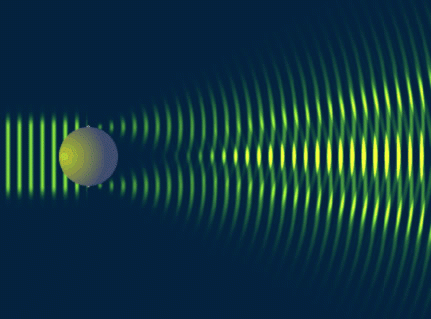Diffraction, in light, a modification which light undergoes in passing the edge of a body by which the rays appear to be bent and to invade the shadow.

One can see the diffraction of light, for example, by looking at a distant light source, such as a neon advertisement through the gap formed between two fingers, or observing the light that flows through the fabric of an umbrella. In general the diffraction effects are very small and should be analyzed and investigated thoroughly.
How was diffraction discovered?
The first thesis on the subject was the priest and scientist Francesco Maria Grimaldi. His explanation, was published after her death, in 1665. He studied concerning the interference that the density of a medium may have on the speed with which light travels in this medium. sHe set a benchmark for water-waves. According to her, just as the waves of the sea “break” when they hit a ship, for example, the light waves also present the same break when they encounter an obstacle. It was from this that the term diffraction was derived, which arose from an expression of Latin that means “to break into pieces”.
Later, Isaac Newton and Christian Huygens launched their theories, contradictory to each other. This is because while Newton argued that there are particles of light, Huygens said that it is actually waves. Although Newton’s theory was the most accepted, Huygens’ theory was not forgotten either. More than a century later, it was Thomas Young’s turn to try to explain factors not addressed by Newton’s theory. But his explanations were also not “perfect.
On the other hand, sound, which it was admitted traveled by waves, is only slightly affected by obstacles. The argument fails because a small source of light does not produce a shadow with a well-defined edge, and, on the other hand, sound may be cut off by an obstacle, if the obstacle be i large enough. The difference is accounted for by I the fact that sound waves are often sev. ft in 1 length, and are therefore not affected by small obstacles, while the mean length of light waves is about 1 fifty-thousandth of an in.
Diffraction is the ability of electromagnetic and mechanical waves to cross obstacles.
Suppose monochromatic light to proceed from a narrow slit towards a screen, and that an obstacle with a sharp edge be placed so that a portion of the light proceeding from the slit is cut off, it is found (hat, instead of there being a definite boundary line between illumination and darkness, a series of dark lines appears parallel to the edge of the geometrical shadow, becoming narrower and closer and more indistinct as they recede from the edge. At first these lines were explained by the interference of waves coming from the source with those reflected from the edge of the obstacle, but it was shown that the sharpness of the edge is immaterial.
It was Fresnel who first proposed the theory of D., developed by Huyghens, which states that each element of any wave-front proceeding from a given source acts as a source of vibration itself, and sends out secondary waves. When the wave front reaches an obstacle, some of these secondary sources are destroyed and the resulting effects on the screen are due to the interference of the waves from the remaining sources. Some of the waves reinforce each other, and some, being in a different phase on account of the slight differences in distance of the screen from the point on the spherical wave-front, tend to counteract each other.
The resultant effect is a series of bands merging into each other, alternately bright and dark. When the source is red light the bands are relatively wide; when the source is violet the bands are narrower, owing to the shorter wave-length. When white light is used the bands are super-posed, and series of prismatic colours is produced.
If light from a small source is allowed to pass through a narrow slit in an opaque screen and then observed through a telescope behind the screen, a bright band of light will be seen, and on each side a series of alternately bright and dark bands gradually becoming less distinct as they recede from the middle band. If a grating composed of a parallel series of fine wires close together bc used, the spectra will be seen with increased brilliance, and the closer such a grating can be made, the more brilliant will be the effect. D. effects by reflected light can be seen by cutting a scries of tine grooves on a plane surface.
The beautiful colours of mother of pearl are due to the striated nature of the surface and not to any absorptive powers inherent in the substance. Thus if a moulding of such a surface be taken in sealing-wax, the same colour effects are produced.
Transmission gratings are made by ruling many narrow lines on glass, say 10,000 per inch, and plastic replicas can be made. Many varieties of D. gratings are available, e.g. concave gratings, and reflection gratings are particularly useful for spectroscopic studies of ultra-violet light.
